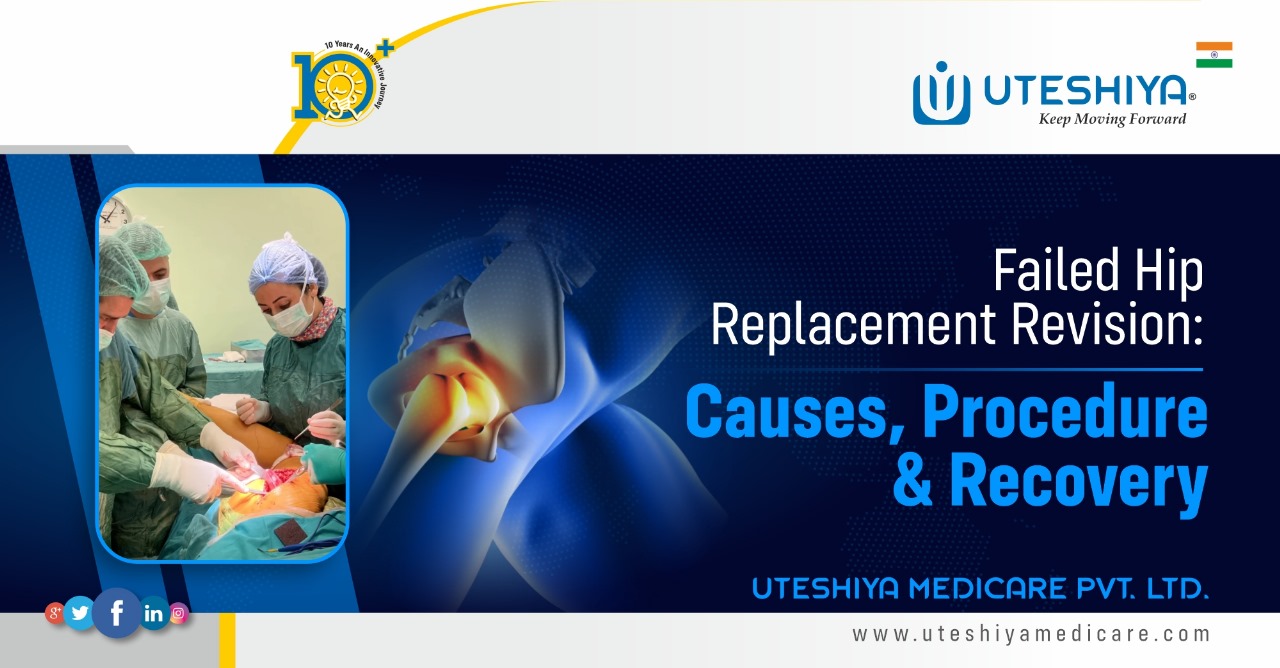Patients suffering from severe hip arthritis or injuries can find relief from pain, more mobility, and a better quality of life with hip replacement surgery, among the most successful orthopedic operations performed internationally. However, hip implants can fail over time, like any other surgery. If problems happen with a hip device that stops working correctly, you need a revision hip replacement. During this process, the failed implant is removed and a new one is placed.
The reasons why a failed hip replacement revision occurs, the symptoms and signs that it has been unable, the surgical methods, the risks, the healing, and the long-term results will all be covered in this blog.
Hip Replacement Failure
Hip replacements are made to last for a long time. Depending on the type of implant and how the patient lives, they can last up to 20 years or longer. Even though implants are very strong, they can wear out, become loose, or fail because of problems with the way they work, infections, or injuries. When this happens, the hip doesn’t work as it should, leading to pain, stiffness, or weakness.
A bad hip replacement doesn’t always mean surgery right away, but revision surgery is often the only way to fix the problem.
Why replacement hips don’t work
A hip replacement could fail for a number of reasons, such as
1. Loosening of the implant
The bond between the device and the bone around it can weaken over time. This relaxation can hurt and make you less stable, making it hard to walk or stand.
2. Wear and tear
Some parts of an artificial hip, like the plastic padding, may break down after years of use. Small pieces are then released into the joint, which can lead to swelling, bone loss, and implant failure in the long run.
3. Infectious disease
Infections after surgery can make a hip replacement less stable and less helpful. Even years after surgery, infections can happen around the implant, meaning the infected tissue and component must be removed during a second surgery.
4. Movement problems
Some patients may have hip dislocation if the implant’s ball keeps popping out of its socket. Revision surgery is often needed after a lot of dislocations.
5 Periprosthetic Breakage
If the bone around the implant breaks, which can happen after a fall or accident, it could hurt the bone that supports the hip replacement. Revision surgery may be needed depending on how bad it is.
6. Metal Sensitivity or Allergic Reactions
Metal ions released by the implant may cause allergic responses in some patients, causing pain, swelling, and implant loosening.
What are the Symptoms of Hip Replacement Failure
If you had hip replacement surgery and any of these things happen, it could mean that the implant failed.
- Persistent or increasing hip pain
- Lack of movement or stiffness
- Pain or swelling around the joint
- Hip dislocations that happen often
- Movement clicking or grinding
- Walking with a limp or feeling unsteady
- Fever or signs of being sick
It’s important to find problems quickly. If you have any of these problems, you should immediately see an orthopedic expert.
What is Surgery to Replace the Hip?
Revision surgery on the hip is more difficult than the first hip replacement. The surgeon surgically removes the old or failed implant and replaces it with new, specialized components that are specifically designed to restore joint function.
Compared to the first hip replacement, revision surgery usually needs more advanced implants, more advanced surgical methods, and more time to deal with bone loss, scar tissue, or infection.
Types of Hip Revision Surgery
The first surgery failed because the health of the bone and organs within it determines the type of revision surgery required.
Partial Revision
Replacing only a single implant component, such as the receptacle or ball.
Full Revision
The ball and socket parts are both taken out and put back in.
Complex Revision
If you have a lot of bone loss, an infection, or a fracture, you may need special implants, bone grafts, or devices that are made just for you.
Surgical Process for Revision Hip Replacement
Usually, the following steps make up the process.
Preoperative Evaluation
Imaging studies (CT scans, MRI, or X-rays) are used to determine the implant’s condition, bone loss, and the adjacent tissues. Blood tests may be done to detect diseases.
Anaesthesia
Most of the time, patients are given either a general or a regional anesthetic.
Removing the Old Implant
The failed implant is carefully removed, which may be more complicated than the first surgery because bone has grown, the cement has hardened, or scar tissue has formed.
Treatment of underlying issues
Infections are treated by removing the affected tissue and sometimes including an antibiotic-filled temporary spacer before putting in a new implant.
Implantation of New Prosthesis
To ensure safety, specialized revision implants, bone grafts, or reinforcement devices are used.
Closure and Healing:
The cut is closed, and drains may be put in to keep fluid from accumulating.
Hip revision surgery complications
The risks are higher for repeat surgery because it is more difficult than the first hip replacement. Some common problems are here.
- Blood clots
- Infection
- Nerve or blood vessel injury
- Fractures during surgery
- Leg length discrepancy
- Dislocation of the new implant
How to Get Better After Hip Replacement Surgery
Most of the time, it takes longer to recover from hip revision surgery than from an initial hip replacement. People may need to stay in the hospital for 4 to 7 days, especially if something goes wrong. Physical therapy is often started soon after surgery to help people regain their strength and movement in their joints. In the first few weeks, patients frequently need crutches, a walker, or a cane to help them walk. Full recovery usually takes between 6 and 12 months, but this depends on things like age, health, and how complex the revision process was.
Hip Replacement Failure Prevention Tips
While not all failures may be avoided, patients can lower their risk by following these steps.
- Carefully following post-surgery instructions.
- Avoiding hip-straining high-impact activities.
- Keep your weight in check to decrease implant stress.
- Seeing the orthopaedic surgeon regularly.
- Report discomfort, swelling, and movement concerns immediately.
Wrapping It Up
Revision surgery can help with mobility and pain after a failed hip replacement. The operation is more complicated than the initial surgery, although surgical and implant advances have increased success rates.
When you experience discomfort or difficulties with movement after a hip replacement, it is important to consult a proper specialist. A hip r for proper diagnosis and immediate relief can improve your quality of life and get you back to what you love to do with proper care.

